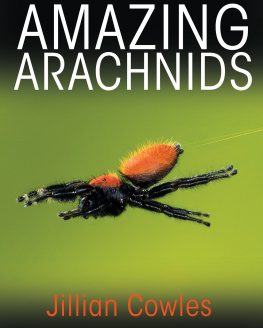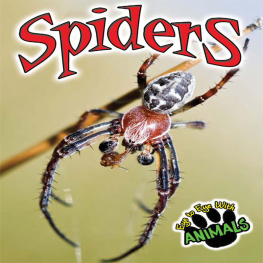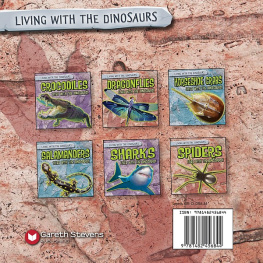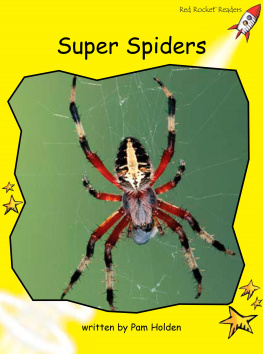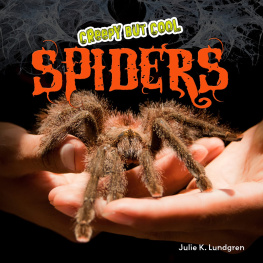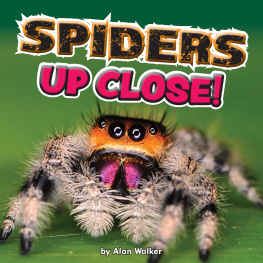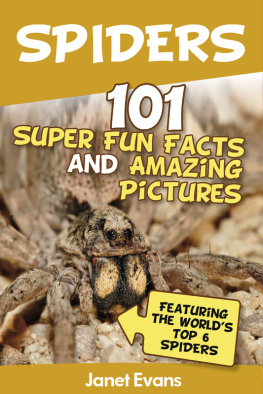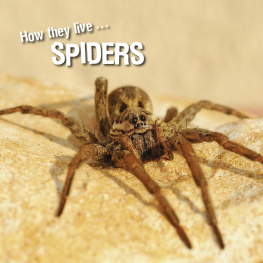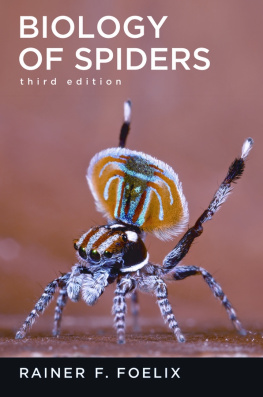
Amazing Arachnids
Amazing Arachnids
Jillian Cowles
PRINCETON UNIVERSITY PRESS
PRINCETON AND OXFORD
Copyright 2018 by Jillian Cowles
Requests for permission to reproduce material from this work should be sent to Permissions, Princeton University Press
Published by Princeton University Press,
41 William Street, Princeton, New Jersey 08540
In the United Kingdom: Princeton University Press,
6 Oxford Street, Woodstock, Oxfordshire OX20 1TR
press.princeton.edu
Jacket image: Phidippus apacheanus. Photo by Bruce D. Taubert
All Rights Reserved
ISBN 978-0-691-17658-1
Library of Congress Control Number: 2017956630
British Library Cataloging-in-Publication Data is available
This book has been composed in Minion Pro
Printed on acid-free paper.
Printed in China
10 9 8 7 6 5 4 3 2 1
Contents
Preface
P eople from all over the world come to the southwestern United States in order to see this hotspot of biological diversity. From creosote flats to mountain forests, from beaches to deserts, the arid southwest is home to a multitude of extraordinary species, many of which are unique to this challenging environment. This book attempts to present the story of one group of southwestern inhabitants, the arachnids.
The need for such a book became apparent to me when I began to learn about them. There were hundreds of publications about arachnids, but most were scattered in dozens of obscure journals. Arachnids other than spiders were almost completely neglected. And finally, even field guides on arthropods focus on regions other than the southwestern United States. Clearly, the story of these amazing creatures deserved to be told. The problem was, how to tell it?
A picture really is worth a thousand words. Very little of the natural history of these creatures had been previously documented in photographs. In this book, photographs capture arachnids hunting, fighting, mating and caring for young. In many cases, these images document behavior that had never been photographed before. Fortunately, the southwestern United States (including Arizona, New Mexico and southern California) is home to all but one arachnid order (the Ricinulei), providing the opportunity to tell the story of arachnids in general through those species found in this region. The story sometimes includes a fourth dimension, time, touching upon how changes over deep time have affected the biogeography of species. In other cases, the story compares and contrasts adaptations seen in these species with related species found elsewhere in the world. This provides a broader evolutionary context for their stories.
In order to address the diversity of species in the region, more than 300 kinds of arachnids are portrayed in photographs. Common as well as rare species are included, chosen as representatives of larger groups of species. Because spiders are an extremely large order, more chapters are dedicated to them. This approach provides an opportunity to explore the rich natural history and diversity of this group.
Terminology used in arachnology can be a challenge. For example, more than one term may be applied to a particular life stage, depending on which order of arachnids is being discussed. Adding to the difficulty, different camps of arachnologists may disagree on the use of a particular term. In this book, I used a very simple criteria for deciding whether particular terminology should be used. If the term is used by arachnologists in currently accepted literature, then I followed their standard. For example, the terms setae and hairs are both used in the current literature; therefore I use both. Technical terms are explained in context as much as possible.
One of the most commonly asked questions about any given arachnid is, Is it dangerous? This book provides practical answers to that concern, providing photographs and information regarding potentially dangerous arachnids from this region. At the same time, photographs of the many harmless species may assist those who simply want to know, What is it?
Ultimately, this book has a dual focus: introducing the arachnids of the southwestern United States, and through them, telling the story of arachnids throughout the world. These small, ubiquitous neighbors have amazing stories to tell. I hope that you will enjoy them.
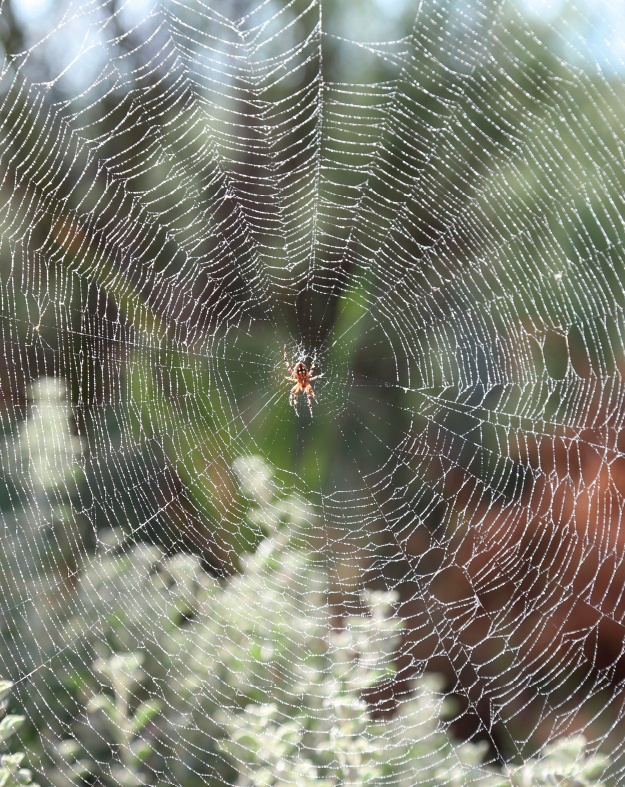
Orb webs are just one of many types of traps and snares constructed of the phenomenal material we call silk. Western spotted orb weaver, Neoscona oaxacensis.
Prologue
A black pit opened at my feet. Staring down into the gloom, I prepared to make the descent down the vertical shaft that made up the entrance into the cave. After donning my helmet and headlamp and taking a few deep breaths, I started to descend. Others had used this path before me; pieces of cacti and rodent droppings were signs that pack rats had been present. A large black widow, plump and glossy, hung belly-up in her web displaying the unmistakable scarlet hourglass of her kind. As I continued deeper into the cave, the daylight faded into a dim twilight at the bottom of the shaft. Only a few feet further and the cave became pitch black. It was here that I searched for my quarry.
My headlamp illuminated an abundance of brown spiders, Loxosceles sabina, closely related to the famous brown recluse. These spiders were on virtually every rock surface, necessitating care in placing my hands when touching any rock. Their venom contains the same necrotizing component, sphingomyelinase D, found in the venom of the brown recluse spider. Although these spiders are not aggressive, one could bite if it felt threatened. These were not my quarry.
Kneeling on the uneven floor, I carefully searched under loose rocks. A surprising variety of fantastic creatures were living under the shelter of the rocks: tiny orange harvestmen, pale pseudoscorpions, booklice, swiftly scuttling scorpions, nymphs of bloodsucking kissing bugs, pillbugs, and tiny cobweb spiders. These also were not my quarry, at least not at this time.
I continued to search, carefully replacing each rock as I had found it. My knees were starting to hurt from kneeling on the rock. My husband patiently stood by, shining his light on the rocks as I laboriously lifted and searched under each one. A tiny animated speck caught my attention. Fingers shaking, I fumbled as I captured the fragile creature, using a delicate paintbrush to gently coax it into a vial. This was my quarry.
As we climbed back up the shaft to daylight, we left behind the brown spiders, scorpions, kissing bugs, and finally even the black widow. I stared into the vial at my prize. It was a tiny spider, only a millimeter in body length, with long, spindly legs. Her cuticle was suffused with a delicate rainbow iridescence, giving her a slightly shimmering appearance. We were the first to have ever seen this species; her kind of Darkoneta had never been collected or described before. I could not have asked for a better gift on Valentines Day.
I had once been afraid of spiders. The journey through the camera lens changed all that. Like Alice in Wonderland, I became caught up in a world of the strange, the fantastic, and the wonderful. The world of arachnids rivals any science fiction creation.
This book is a small token of my appreciation and gratitude for these amazing creatures. I hope that you will enjoy your journey into their world.
CHAPTER 1 Introducing the Arachnids
Next page
